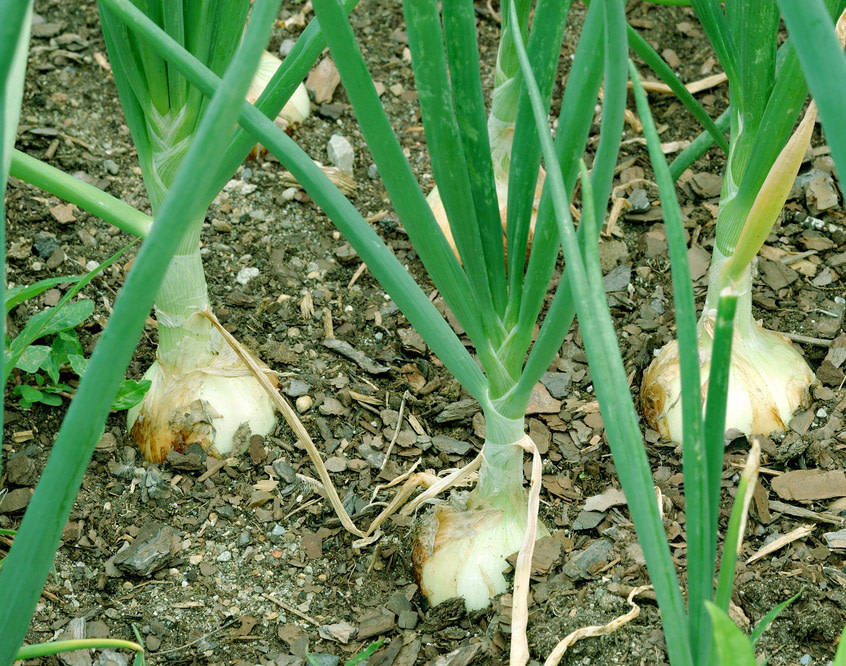The Onion, Published in Walla Walla

Walla Walla sweet onions can be eaten green tops and all if you harvest them early, as "babies." Full size (i.e., jumbo) Walla Wallas will be ready for harvest by mid-June and available for a couple months.
Image: Anne Kitzman
Before Walla Walla, WA was a gourmet food and wine travel destination for Portlanders and Seattle-ites, it was famous for its sweet onions. Yep – those onions that are in perpetual rivalry with the other famous sweet onion, the Vidalia, named for the Georgia town in which it’s grown.
Vidalia onions must have a bigger marketing budget, or maybe it’s just that I grew up on the East Coast, because it seems like Vidalias have gotten the lion’s share of attention when it comes to sweet onions. But here in the northwest we know that Walla Walla sweets are where it’s at.
Not unlike Champagne, or "sparkling wine," sweet onions are known by the name of the region in which they’re grown. There are Vidalia sweets, and Maui, and Texas...and Walla Wallas out here in the Northwest, specifically in the Walla Walla Valley, in southeastern Washington and northeastern Oregon. Washington designated Walla Walla sweets its official state vegetable in 2007, but they've been grown since French soldier Peter Pieri emigrated with a Corsican onion seed in his pocket and planted it in the volcano rich soil of the Walla Walla Valley around 1900. (Vidalias are a cultivar, and only grown since about 1930. So take that, Georgia!)
The famously big, round, and juicy onions are said to be worthy of biting into just as you would an apple. And that is indeed a perfectly acceptable method of “serving” a Walla Walla sweet. But there are other delicious ways that don’t require such a leap (bite?) of faith.
The softball sized mature Walla Wallas aren’t quite read for harvest yet – the crops should start rolling in by mid-June, and keep rolling through September. But right now you can whet your appetite with baby Walla Wallas. Like other “baby” onions, baby Walla Wallas are picked young and small, with their equally edible green tops still attached (like leeks, scallions, ramps, or garlic scapes).
Baby or not, while Walla Wallas are sweet, they don’t actually have a higher sugar content than common yellow, white or red onions. They do, however, have a higher water content, which makes them so juicy – and also more perishable than other onions. So while typical onions are a long lasting, year round crop you can store for months, Walla Walla and other sweet onions are in season for only about three months and can store for only about three to six weeks. (Evidently putting them in a stocking with a knot tied between each onion is the best way to keep them fresh and safely not touching each other. This I do not know from experience, however.)
Walla Walla onions are sweet not just because of taste but because they don’t make you cry. The lachrymator released when you slice into a common onion is related to the onion’s pyruvic acid content, which is substantially lower in Walla Wallas than in typical onions. So slice away. You won’t need to wear goggles.
As for how to prepare Walla Walla sweets, simply slicing raw and adding to salad or a burger is the classic. Sauteing in oil will of course soften and amp up the sweetness. They’re great added to any stir-fry and accompanied by pasta or whole grains, or caramelized as a topping for steak. If you want to really live it up with the Walla Wallas, get out the deep fat fryer and try this recipe for Onion Strings, brought to us by the inimitable food blogging Pioneer Woman. They’re flower-battered, cayenne-peppered and decadently crispy. A completely different way to enjoy a Walla Walla sweet than to treat it like an apple!
The town of Walla Walla is a worthy travel destination any time of year (for the wine, good food and small town charm), but the Walla Walla Sweet Onion Festival ups the ante July 20-21, 2013.
